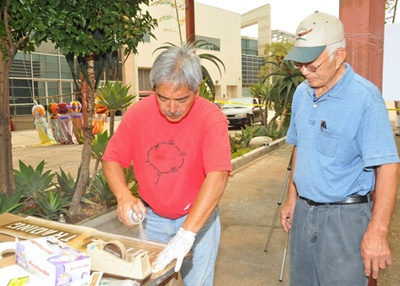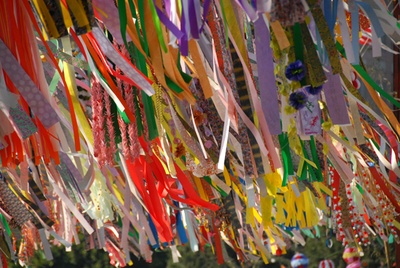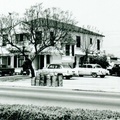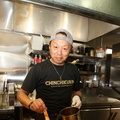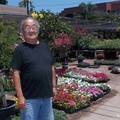For the very first time, Tanabata Matsuri was featured alongside the customary events and exhibitions in the 69th Annual Nisei Week Japanese Festival. A total of over 250 tanabata ornaments were put on display at the Japanese American National Museum and at the field in front of the Los Angeles Museum of Contemporary Art. Countless volunteers were involved in the making of the ornaments, led by many Southern California Kenjinkai (Prefectural Association) members and Nikkei community groups, as well as several groups and members outside of the Nikkei community. This became somewhat of a groundbreaking event, introducing a number of Nikkei community groups that otherwise may not have interacted with each other, bringing together a mix of various ethnicities, and strengthening bonds between family members that may have been experiencing a lack of conversation in the household. It was an event that realized the long time dreams of Yoshihito Yonezawa, chairman of the Nanka Miyagi Kenjinkai (Miyagi Prefectural Association of Southern California)—but it goes without saying that it took a collective understanding and concerted effort from countless individuals to bring this dream to reality. Still, had Yonezawa not met the Little Tokyo Public Safety Association Chairman Brian Kito—who would later become chairman of the LA Tanabata Matsuri Planning Committee—none of this may have gotten started. In that sense, this “meeting” of these two men was extremely critical. It was, so to speak, The Meeting of Two Dreams.
It has been a long time coming since Yonezawa, a native of Kami-machi (the former Nakaniida-machi) city in Miyagi prefecture, had first sought to hold a tanabata matsuri in Los Angeles. He came to the United States as a 26 year old in 1956 to help his uncle, a farmer in the Imperial Valley, but since had returned to Miyagi from time to time as an active member of the Nanka Miyagi Kenjinkai . With each visit, he received continuous support from the prefecture and the city of Sendai. As a gesture of “giving back to my hometown,” he longed to organize a tanabata matsuri here in Los Angeles.
Of course, to realize such a dream by himself was impossible. Who’s support could he count on? Yonezawa had thought about this for many years, and after reading about the activities in the Nikkei community through newspapers and magazines, as well as hearing stories from fellow community members, he decided to contact Brian Kito of Fugetsudo (a confectionary store in Little Tokyo). Yonezawa explains, “If we could have a conversation, straight from the gut… I felt he would be the kind of person who would help me out.” They had never spoken directly before, so he came up with the idea to invite Kito to the Miyagi Kenjinkai picnic, in hopes that he would attend and find out what the tanabata ornaments were like. In preparation, he would make tanabata ornaments with his family to put on display at the picnic. In order to meet Kito, Yonezawa headed out to Fugetsudo in Little Tokyo. This occurred in June of 2008.
Waichi Kito’s Wish
At the time of the visit, Kito was at nearby Little Tokyo Koban (police station). The Koban is the headquarters of the Little Tokyo Public Safety Association, for which Kito serves as chairman.
Recalling the visit, Kito mentions that he immediately “got the feeling that [Yonezawa] was just like my father, who had passed away three years ago.” His father was the chairman of the Nanka Gifu Kenjinkai (Gifu Prefectural Association of Southern California), Waichi “Roy” Kito.
Waichi Kito had dedicated many years to perfecting the art of manju (traditional Japanese pastry) making, and therefore felt deep pride for Japanese culture. His store was in the heart of Little Tokyo, and he enjoyed the Nisei Week festivities every year. One year, it was announced that the festival would feature the Aomori nebuta (traditional float from the Aomori prefecture), so he was especially looking forward to the parade that year. Unfortunately, Waichi Kito had passed away without ever witnessing the nebuta in action.
Brian Kito’s mother had passed away seven years prior, so with the passing of his father, he was saddened to be “without the old folks that I would usually be looking after.” It was just then that Yonezawa had carried his hopes over to Kito. Meeting Yonezawa—who suddenly appeared at the Koban to say, “Listen to my dream”—had struck a chord deep within Kito.
“At the time,” Kito explains, “I still had a lingering feeling of wanting to fulfill my father’s wish.” The wish was to see a celebration of Japanese culture that can be truly enjoyed from the bottom of the heart, and Kito dreamed of fulfilling this wish. As such, there was a common ground over which Kito and Yonezawa empathized. Speaking passionately in his broken English, Yonezawa had slowly began to overlap with the silhouette of Waichi Kito inside Brian Kito’s mind.
To begin, Kito attended the Miyagi Kenjinkai picnic and viewed the tanabata ornaments. He was moved upon hearing that the Yonezawa family had made the decorations themselves—but that wasn’t the only thing that inspired him.
“I think that there are two sides within me: one side that has deeply embraced the American culture, and the other side that has been passed down from my father—in other words, the side of me that holds pride in my Japanese heritage. I felt like the tanabata matsuri would be something that can bring together these two sides that lie inside of me. I guess because I wished to combine something that is ‘Japanese’ and ‘Nikkei’ into one, I thought, ‘Maybe I can accomplish this by working together with [Yoshizawa].’”
With that thought in mind, committee meetings began in March to bring their plan into reality. Every Wednesday night, participants and volunteers gathered at the Koban as discussions continued to mount. Before long, Kito had begun referring to the Yonezawa’s as “ji-chan ” and “ba-chan ” (gramps and grams).
Thereafter, Kito, along with a planning committee supporter, headed over to Miyagi to purchase tanabata supplies. He even met Ichiro Shiramatsu, president of Sendai’s famous patisserie, Shiramatsu-ga-Monaka Honpo , and a strong supporter of the Nanka Miyagi Kenjinkai for the tanabata project. To think that none of this would have been possible without the meeting of Kito and Yonezawa—one cannot help but wonder in amazement about the chance encounter of individuals in this world.
On a side note, it turns out that Yonezawa’s wife had worked at Fugetsudo at one point before their marriage. Perhaps, like Kengyu (Altair) and Shokujo (Vega), Kito and Yonezawa have always been connected with an invisible string, destined for their dreams to meet.
>>> Read Part 2
© 2009 Yukikazu Nagashima



